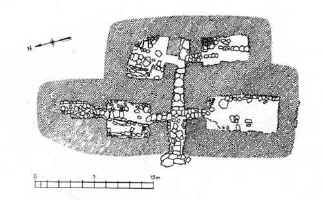
The next stage of development of the turf farmhouse was that the entrance was moved, to be located between the skįli and the stofa. This led to a new feature, the corridor, which was to make its mark upon the turf house. Forna-Lį is the oldest extant remnant of a gangnabęr (corridor farmhouse); it is believed to have been inhabited last at some time between 1450 and 1550. This was not a large farmhouse, but the ground-plan is the same as was familiar in later centuries. The length of the building, at the front, was about 20 metres. The buildings were arranged symmetrically on either side of the corridor. At the left front was the skįli, with the pantry leading from it. The stofa was to the right of the entrance. At the far end of the corridor, to the left, was the kitchen; opposite it was the bašstofa (bathhouse), a kind of sauna.
The corridor-farm was the predominant form of building in the north of Iceland until the 20th century. One may reasonably deduce that this form of building was the Icelanders' response to a colder climate. Many believe that it originated in Greenland, and it is probable that it first became common in the north of Iceland. The longhouse, on the other hand, is known to have remained common in the south until the 18th century, or even longer.
One of the results of the colder climate was a lack of fuel for heating, and this led to changes in the way the accommodation of the turf house was used. The bašstofa stood higher than other parts of the house, and farther from the door, so it was warmer than the other rooms. As a result, what had once been the bathhouse took over the role of the stofa, where people worked, ate and spent their leisure time, although they continued to sleep in the skįli. The bašstofa stove was in some cases moved into a separate unit, the ónstofa (stoveroom), next to the bašstofa. The stove was only lit in severely cold conditions. On the largest farms, the stofa became a reception room, while on the smaller farms it disappeared entirely.